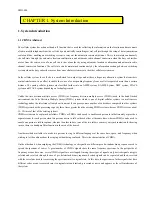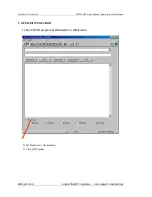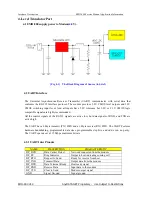
Interface Description EMII-800 Service Manual Application Information
EMII-800 V1.0 AnyDATA.NET Proprietary
Use Subject to Restrictions
1. Overview
IFR3000 receives modulated digital signals from the MSM of the digital circuit and then, changes them into analog
signals by the digital/analog converter (DAC, D/A Converter) in order to create baseband signals. Created
baseband signals are changed into IF signals by RFT3100 and then, fed into the Mixer after going through AGC.
IF signals that have been fed are mixed with the signals of VCO and changed into the RF sign als and then, they are
amplified at the Power AMP. Finally, they are sent out to the cell site via the antenna after going through the
isolator and duplexer.
2. RF Transmit / Receive Part
2.1 CDMA Transmit End
8 bit I and Q transmit signals are inputted into 2 DACs (DIGITAL-TO-ANALOG CONVERTER) from the output
terminal TX_IQDATA0 ~ TX_IQDATA7 of MSM through the input terminals TXD0~TXD7 of BBA. Transmit
signal input speed is two times of TXCLK+, TXCLK- which are two transmit/receive reference frequen cy.
Among transmit signals being inputted, signals are inputted into I signal DAC when the transmit clock is in the rise
edge, whereas signals are inputted into Q Signal DAC during the drop edge. I and Q transmit signals are
compensated and outputted at MSM in order to compensate the 1/2 clock time difference generated between
reference clocks. In the signals coming out from the output terminal of DAC, there are spurious frequency
ingredients resulting from DAC output transition edge and parasite ingredien ts, transmit clock frequencies and
harmonics which are unwanted signals. Accordingly, spurious ingredients are removed by passing the signals
through LPF of passband 6.30KHz. Unlike the receive end, the transmit end LPF requires no OFFSET adjustment.
Analog baseband signals that have passed the CDMA LPF are mixed with I and Q signals of frequency 130.38
MHz (260.76 MHz created in the BBA internal VCO are divided by half into frequency 130.38MHz having the
phase difference of 90 degrees) in two mixers. The mixed signals are added again and converted into IF frequency
130.38 MHz
630 KHz (CDMA Spread Power Density Modulated Signals) and then, outputted.
2.2. Tx IF/Baseband Processors, RFT3100 (U102)
The RFT3100 connects diretly with QUALCOMM
…
s MSM5100 utilizing an analog baseband
interface. The basebaand quadrature signals are upconverted to the Cellular or PCS frequency
bands and amplified to provide signal drive capability to the PA. The RFT3100 includes an IF
mixer for upconverting analog baseband to IF, a programmable PLL for generating Tx IF
frequency, single sideband upconversion from IF to RF, two cellular and two PCS driver
amplifiers, and Tx power control through an 85 dB VGA. As added benefit, the single sideband
upconversion eliminates the need for a bandpass filter normally required between the upconverter
CHAPTER 3. Circuit Description
















































